
Architectural Styles and Revivals: The Queen Anne Style
(written by Dr. Les Crocker, UWL Emeritus Professor of Art History)
The Queen Anne Mess
This style was developed and named by Richard Norman Shaw in England and claimed to be based on design elements used in the time of the English monarch Queen Anne. As the style moved to the United States, it lost many of medieval elements. These were replaced by Italian Renaissance forms which had been present in the preceding Italianate style. Wood as the predominant material was another change. Wooden structural and decorative forms allowed a visually lighter style with many decorative features that were difficult to create in stone or brick. Imagine a row of spindles and spools on the Knudson house porch in stone instead of wood. Not going to happen.
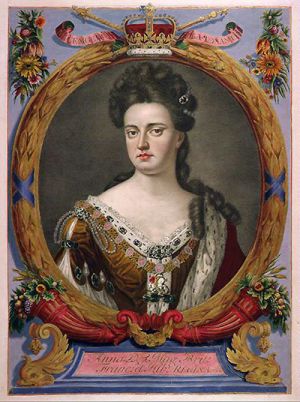
A portrait of Queen Anne from 1707. Her reign was over more than 150 years before the architectural style bearing her name would become popular. Image: public domain via Wikimedia Commons.
Another factor that plays a part is new technology in woodworking. New types of lathes could cut hundreds of different designs for porch posts; flutes and even spiral flutes could be quickly carved, a ball on a stick spindles were produced by the thousands. Steam powered scroll saws with thin straight blades could cut curves that were only possible before in hand work. Industrializing the manufacture of architectural decorations made them inexpensive and thus, more common.
In England, the Queen Anne style is indeed the revival of an earlier style sometimes used in houses. It used heavy timbers that are visible on the exterior with plaster panels imitating the old wattle and daub construction used for most inferior buildings. Often a ground story of brick would be used with an upper story of timber and plaster. Of course, the United States did not exist when Anne was Queen and so some historians claim the Queen Anne buildings are a style, but should not be called a revival. It's a dumb argument. There weren't any original Roman, Greek, or Gothic buildings in the United States either, so they shouldn't be called revival styles. Names are important, but in all branches of history inconsistencies abound.
The Queen Anne style has been called the first nationwide style in the U.S., but such a claim requires lots of twisting the meanings of “first” and “nationwide”. Even at the zenith of its popularity there was a lot of confusion over the characteristics of the style.
According to art historian Alan Gowans‘ research in his book The Comfortable House, in 1880, a “T.D.G.” of Carson, Iowa, wrote the editors of the very popular Carpentry and Building magazine:
“Would you be so kind enough to illustrate through the column of your journal the characteristics of the ‘Queen Anne,’ ‘Elizabethan’ and ‘Eastlake’ styles of architecture? Volume I of your journal treats the subject briefly, but I cannot distinguish the different styles from what I find there.”
I suspect Mr. T.D.G. was not satisfied with their response:
“It is quite impossible to say nowadays where one style begins and another ends. At present, they are rather names than styles and architects use them without any very clear idea of their meaning, in a great many cases. An attempt at classification would, we fear, be misleading.... At present our architects are so much in the habit of calling an eccentric design by any name that is likely to please the owner, that until something like a style has been developed out of all this confusion, it will be difficult to discuss intelligently the meaning of the various names in common use.”
But a single style never developed out of all that confusion.
We assume that houses in the same style would have similar features, but when we look at the two most prominent examples in La Crosse they have very little in common. Some details certainly, but overall, they are very different. So, what is going on?
The Gantert House 1304 Main St., 1891
The Crosby House, 221 S. 10th St., 1888
The Gantert house, designed in 1891 by Hugo Schick and Gustav Stoltz for the furniture dealer and his large family fits the image of a Queen Anne house perfectly. Two stories tall, a circular three-story tower, wrap-around porch, fancy turned columns and very tall, decorated chimneys; it has all the features one expects in the Queen Anne Style.

All of the different finishes and decorations are on full display thanks to an intricate color scheme on the Gantert house. 2020 photo by author.
The bell-shaped tower cap and the lovely, but non-functional, bay window in the gable are extra delights. Notice the third-floor porch with the round arch. When the house was remodeled, the owners enclosed the porch but put the glass and its framing on the inside of the opening so the original shape and decorations around the arch would not be obscured. That is good preservation.
Smooth exteriors are not allowed. The surface is covered with panels, shingles, insets, triangular pediments, a small semi-circular pediment. Only small areas have the narrow horizontal siding that we would expect.

The varied details of the upper floor are evident here. 2023 photo by author.
Only a few blocks away the Crosby house designed in 1888 for W. W. Crosby by James Douglas, a nationally known architect from Milwaukee, looks very different.
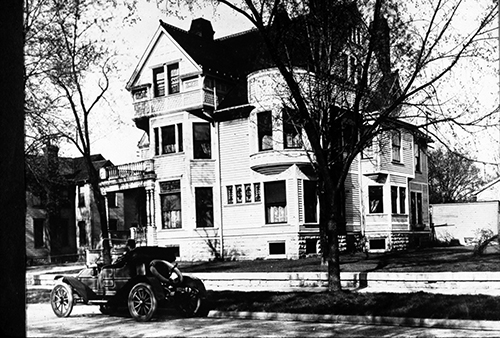
A motorist is parked outside the Crosby house in this photo from the 1910s-1920s.
While the Gantert house has a significant tower, the Crosby house has only a simple turret. The Gantert house has a large wrap-around porch, but the Crosby house has only a small porch that would be suitable for an Italianate style house. The Gantert house is somewhat rambling, while the Crosby house is very compact--as if for a narrow lot, but Crosby had plenty of space.
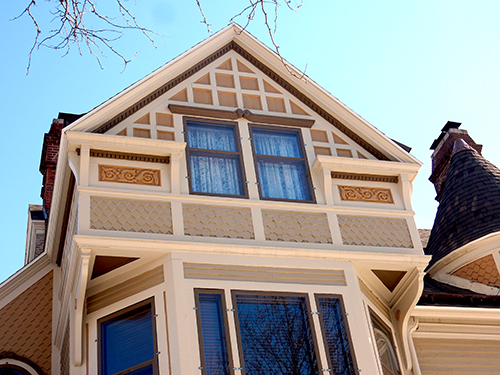
On the front of the Crosby house a two-story bay with angled sides is capped by a gable with a rectangular base. 2021 photo by author.

On the south side a one-story bay with angled sides supports a second story rectangular bay. Lots of different surface levels creating various shadow patterns. Major gables on the third level are filled with windows surrounded by decorative shingles and panels. 2021 photo by author.
Another question to Carpentry and Buildings in 1886 shows the continued confusion: “Would a house with two gables be in the Queen Anne style, or to entitle it to this name must it have twenty gables or more? What is necessary to entitle a building to the name of Queen Anne?”
The editor’s reply was essentially, “we give up”. Shortly after, the magazine went out of print.
In 1883, the architectural historian Montgomery Schuyler had this to say, “Queen Anne is a comprehensive name which has been made to cover a multitude of incongruities, including indeed, the bulk of recent work which overwise defies classification and there is a convenient vagueness about the term which fits it for that use.”
The Alexander Hyslop House, 122 S. 10th St., 1882
To complicate things even more, it seems likely that the Alexander Hyslop house may be the first manifestation of the Queen Anne style in La Crosse and it doesn't look like either the Gantert or the Crosby houses. The full front gable, the gable within a gable, the gabled dormer windows on the east side, the sort-of classical porch columns are all part of the style and first used at this house. More research needs to be done to determine the importance of this house.

The Hyslop house doesn’t seem doesn’t seem like the Queen Anne style at first glance, but the details are there, especially in the shingled, full front gable. 2023 photo by author.

More Queen Anne details are visible in this view. A half-timbered dormer window peeks out next to a cross gable. 2023 photo by author.
If neither the popular magazines of the time devoted to the topic, nor an architectural historian could define the style, perhaps the passage of time has given us some aid toward that goal.
An Organized Mess
In her Field Guide to American Houses, first published in 1984, Virginia McAlester attempts what those editors couldn’t and breaks down and identifies the Queen Anne style by its parts. She defines sub-styles of the Queen Anne based on their shape and roof forms: hipped roof with lower cross gable, cross gable roof, front gabled roof, full width front gable, and more. She uses another four sub-styles based on materials and decoration: spindlework, half-timbered, patterned masonry, free classic. It gets complicated at that point. McAlester’s divisions are based on her experience on the East Coast and don't work as well in the Midwest, where architects and clients cared less about conforming to any particular style; don't be concerned if her drawings and photos don't always agree with what you see around us. Despite the complications, there are examples of many of McAlester’s sub-styles in La Crosse.
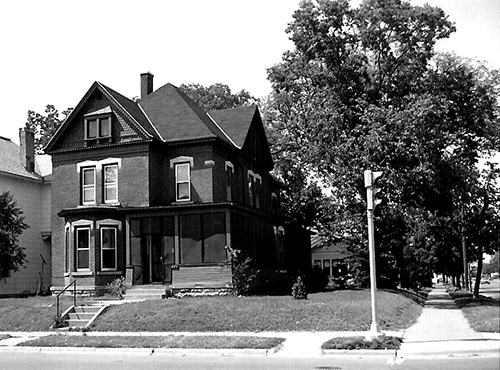
The August Miller house at 1145 State built in 1885 is an example of a hipped roof with a lower cross-gable. The oriole windows in the gables are the only other use of the Queen Anne style. 1980 photo by author.

An example of a cross-gabled roof, the house at 821 S West Ave has a roof of the same height on each section. Often a tower would be located at the intersection. This is the continuation of a plan developed in the Italianate style. 2011 photo by author.
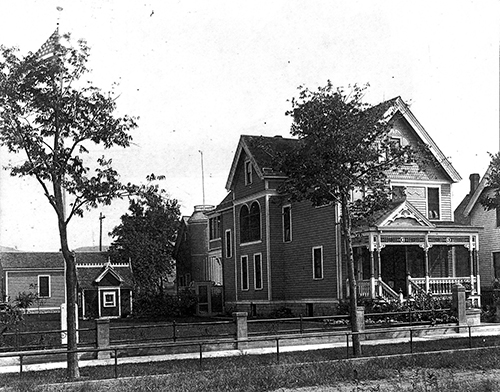
The Lewis Knudson house at 323 S. 20th St. and built in 1896, is an excellent example of a front-gabled roof. Its porch is also a great example of Queen Anne decoration with lots of spindles set in a pattern, lathe-turned porch posts with decorative capitals and fantastic railings.

This house at 1328 State has loads of spindlework, a Palladian arched porch, a two-sided oriole window on the second and attic levels, plus a Stick style use of horizontal and vertical non-siding boards that outline the house and link the sills of all the windows on the second level.

The Joseph and Anna Pavek house at 1208 S. 4th St. is a middle-class house. Joseph was a blacksmith, but later became a grocer. Spindlework, turned porch posts and a few areas of shingles link this house to the Queen Anne and show how decorations and house size decreased as we look further down the economic scale.
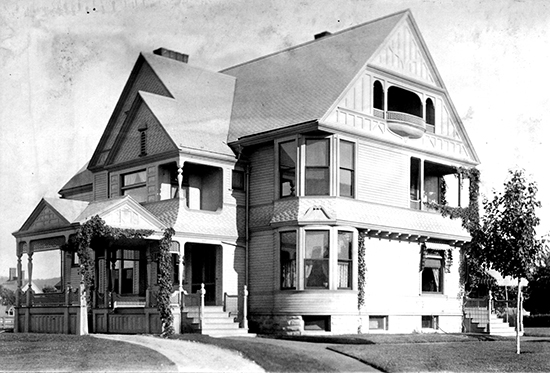
The Lucius Charles Colman house at 207 West Ave South was one of the earliest Queen Anne houses, built in 1883-84. It has a gable covering the entire front. In the large gable, flat boards imitate the half-timbered look that was a characteristic of the style. They certainly aren't convincing as large timbers, but the architect did not intend them to be seen as ‘real.’ They are just one more form of flat decoration to cover the surface.
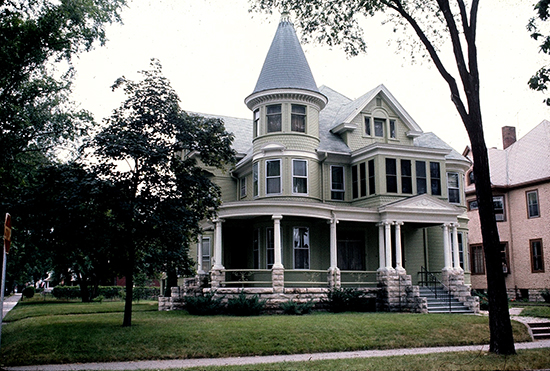
The Ott house at 1532 Madison from 1897 is very similar to the Holway house, but without the stone and no Romanesque revival elements. It has the tall tower, wrap around porch, classical columns and Palladian window common to the Free Classic sub-style.
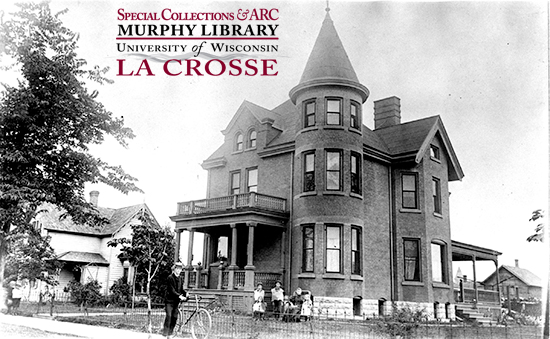
The Rynning house at 1416 Charles St. dated 1894, is a brick version of a standard Queen Anne with a three-story corner tower with conical cap, a decorated chimney, and classical columns on pedestals supporting a balustraded, flat porch roof. A large pedimented dormer with a pair of windows breaks the cornice line.
So how did we end up with a major “style” that had so many variants that even the professionals were unable to define it?
By 1880 newspapers, magazines and many books promoted their own versions of the style, unlike earlier styles where only a few sources were available to guide the local carpenter. These multiple sources make it very difficult to determine where any particular version of the style may have originated.
The Queen Anne style had no cultural history in the United States. The Greek and Roman worlds had contributed much to Europe and the Europeans brought that cultural context to the new world.
Americans had little knowledge of Queen Anne, or any other British royalty between Henry VIII and the Georges. With no firm historical background, no tradition of particular materials or specific forms, like columns, pediments, pointed arches, the style could be anything you wanted it to be.
That is why the Queen Anne style is a mess.
Next week, we will jump ahead to examine how the Colonial Revival era shows up in La Crosse architecture. But we haven't forgetten the Romanesque Revival! More on that style to come...
Other entries in this series
Architectural Styles and Revivals
Architectural Styles and Revivals: The Greek and Roman Revivals
Architectural Styles and Revivals: The Gothic Revival
Architectural Styles and Revivals: The Exotic Revival
Architectural Styles and Revivals: The Italianate Style
Architectural Styles and Revivals: The Second Empire Style
Architectural Styles and Revivals: The Colonial Revival
Architectural Styles and Revivals: Romanesque Revival Public Buildings
Architectural Styles and Revivals: Romanesque Revival Commercial Buildings
Architectural Styles and Revivals: Romanesque Revival Homes
